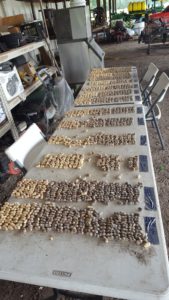County Agents are known throughout the peanut belt for their willingness to “pod blast” peanuts and assist peanut farmers with digging recommendations. This process involves using a small electric pressure washer with a turbo nozzle. As peanuts mature, the mesocarp color changes from white, to yellow, orange, brown, and finally black. Although the yellow and orange kernels will contribute to the grade of the harvested crop, given adequate time before harvesting, they will increase weight and grade. Returning more money to the farmer. Generally speaking 500 to 750 pounds of yield, or $125 to $150 per acre greater return are possible from optimum harvest timing.
The peanut maturity board is the most common method of assessing peanut maturity. I also like to use some variation of the “simplified three pile hull color method. The Clemson University Peanut Money Maker Guide gives specific instructions on the method. The Peanut Money Maker Guide can be found here. However, the simple method is to sort pods into one of three piles; white to yellow, orange, and brown/black. For runners, the target is to have 75 to 80% in the orange+brown+black categories. About 40% of peanuts in the brown to black category.
I use a bit of my own experience/interpretation of this method, stacking peanuts in black, brown/orange, and yellow/white categories. This method allows us to easily compare difference in maturity among fields. The main caution to be aware of is that peanut maturity is important, but vine condition is often a more important factor. Timely harvesting is complicated process of agronomics, equipment, labor, and weather. So no one program works for everyone.

